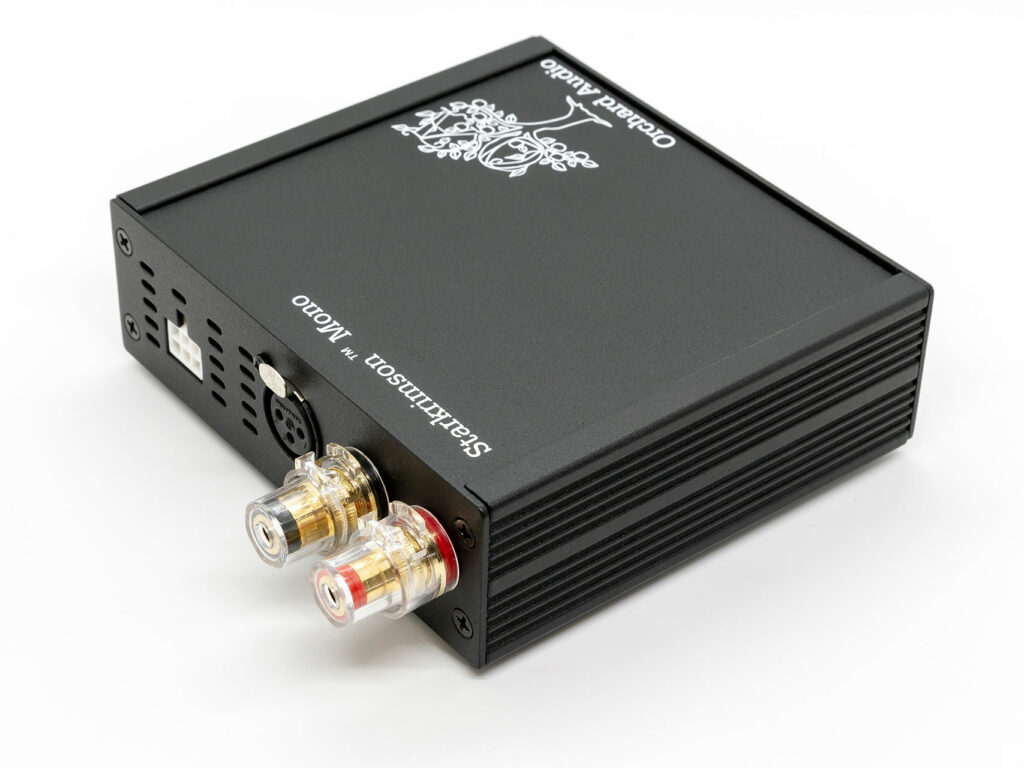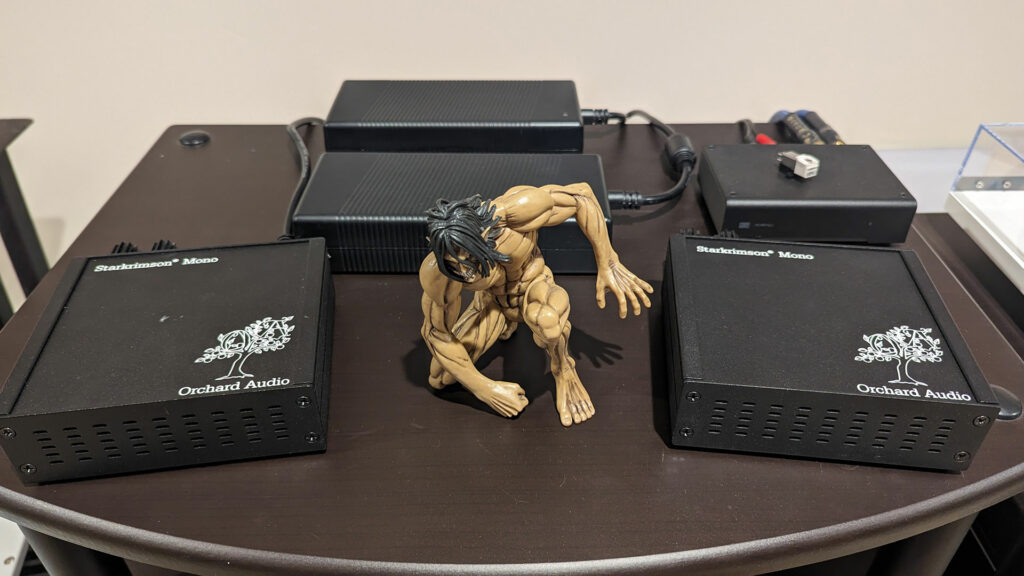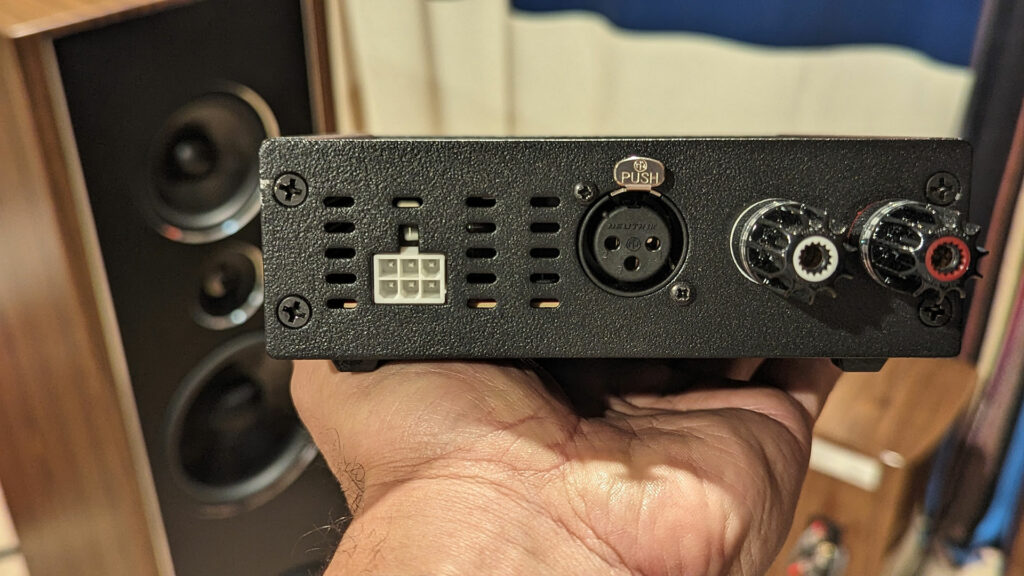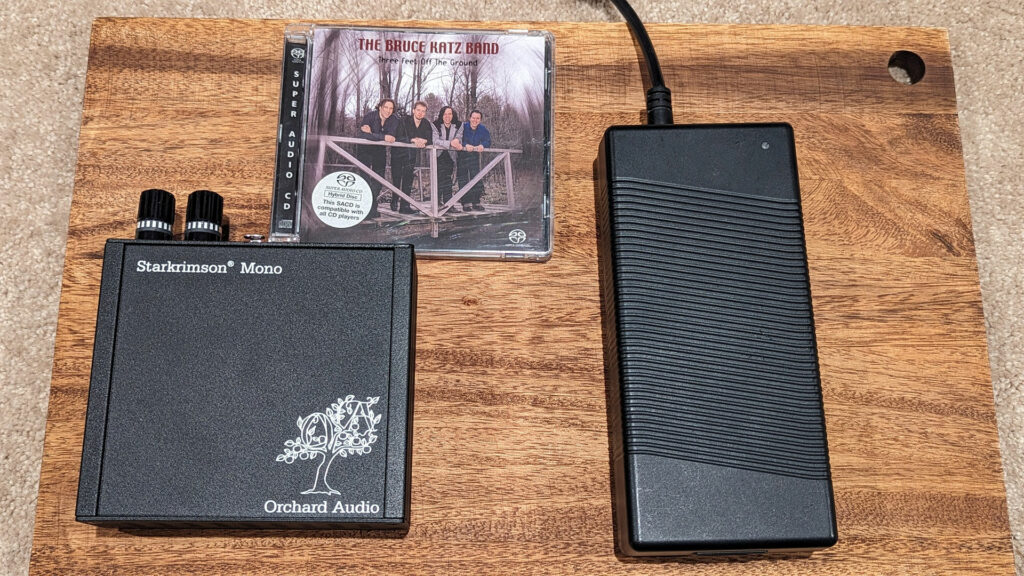Orchard Audio is a six-year-old audiophile electronics company that is the brainchild of an electronics engineer named Leo Ayzenshtat. Leo has earned his stripes by designing digital electronics for satellites. Yes, the ones that orbit the Earth and cost more than the GDP of many small nations. It is no wonder that Orchard Audio embraces our audiophile future with forward-thinking audiophile components, including their Gallium Nitride (GaN)–based Starkrimson amplifiers. It is amazing how far GaN Class-D amplification has come in only a few short years. While holding one of the Starkrimson monoblock amplifiers in my hand, I found myself admiring its form factor and weight, which is akin to a necklace box from a fine jewelry store. I was excited to think: Can a pair of these little jewels really compete with amplifiers five times the size and tenfold the weight? I currently have several GaN-based switching amplifiers in my system, all of which perform as well and sound very much like more high-maintenance and high-heat Class-A amplifiers. However, I found the Starkrimson monoblock amplifiers bring something special to the table, which gives them a value worth exploring.

What Makes the Orchard Audio Starkrimson Mono Amplifiers So Special?
- The Starkrimson monoblock amplifiers pack a punch at 150 watts into four or eight ohms with 300 watts peak power. The impact is a skilled, one-inch-punch from a martial arts master. It is swift, unnoticeable, and its power is focused where it counts, but its performance is powerful.
- Orchard Audio posts full specifications and measurements for the Starkrimson monoblock amplifiers. No voodoo here – just great engineering and the data to back it up. We love this level of transparency in the audiophile hobby.
- The Orchard Audio Starkrimson mono amplifiers are small enough to fit anywhere. Really, these things are quite physically small. Each Starkrimson monoblock amplifier is smaller than the half-dozen CD cases stacked on the edge of your listening rack. One of the reasons the Starkrimson monoblock amplifiers are so small is the separate power supply. The 250-watt power supplies I received are approximately the size of a laptop computer power block, and can be stowed neatly behind your audio rack.
- The Starkrimson monoblock amplifiers’ soundstage is extremely accurate, while they deliver a delicate touch sonically. Video projector owners know that the quality of the picture in their home theater is only as good as how dark their room can get, thus affecting their real-world, in-room contrast ratio. Audiophile amplifiers are sort of like this, too, in an odd way. Many audiophile power amps will seem like they are projecting the sound in the audio equivalent of a bright room. Quiet amplifiers, like the Starkrimson, present the soundstage into what sounds like a pitch-black room. This brings out the fine details in the sound, as background noise is the enemy of a good audiophile system. I found myself averaging lower listening levels, like I do with my reference audiophile amplifiers, the Bricasti Design M30 monoblocks, because I was getting everything I wanted out of the music, without the need to overcome the noise floor. This helped create a delicate listening experience that I was captivated with for hours.
- The small enclosure and connections are solid, with a high-quality feel. The review pair of amps that I received had the WBT binding post upgrade, which made connecting the spade ends on my heavy speaker cable a breeze.
- For $300 more, you can increase the power or transience response with larger power supplies even though the power rating stays at 150 watt per channel. The power isn’t the draw here, but all of these new Class-D amps benefit from a better power supply, and Orchard Audio is no exception. $300 is a small price to pay to improve the most impactful part of any new-school Class-D amp.

Why Should You Care About the Orchard Audio Starkrimson Monoblock Amplifier?
I have been closely following GaN, and have experienced different GaN amplifiers in my system since they gained recognition in the audiophile community circa 2017. One GaN amplifier, the $5,500 AGD Production’s Tempo amplifier, replaced my decades-standing Parasound A21+ (Parasound A21, prior to that) as my secondary amplification source, since the Tempo was a new level of higher performance. Now that GaN switching (Class-D) amplifiers have become more established, we are seeing it adopted by both existing companies like Peachtree Audio in their GaN 1 (read my new review here), and newer companies like Orchard Audio. These newer companies are driven by the next generation of keen audio electronics engineers, such as Leo Ayzenshtat. Constant fresh perspectives on a new technology are important, because they provide a unique look at the technology, driving it forward, while keeping the first-to-market companies honest, requiring them to keep up with technological advancements.
At $1,599 for the pair, the Orchard Audio Starkrimson monoblock amplifiers are the lowest-priced traditional GaN amplifiers that I have had in my system. Despite the low cost, they did not sacrifice the quality of the sound, which is often directly related to the cost of the amplifier. For example: The $1,599 Starkrimson monoblock amplifier should not sound as good as a $5,500 amplifier like the AGD Productions Tempo. Yet, instead of being in a lower component class because there was a cost-down need to sacrifice engineering or parts quality, the Starkrimson could easily be considered as good as the AGD Productions Tempo, but just with a slightly different presentation of the sound that I would not say is better or worse. This puts the $1,599 Orchard Audio Starkrimson in a competitive class with the AGD Productions Tempo, and if the Tempo is considered a very high performer at $5,500, what does that make the Starkrimson monoblock amplifiers in terms of an audiophile value? How about a game-changer, and yet another disruptive force from the world of these new Class-D semiconductor-based amps.

Some Things You Might Not Like About the Orchard Audio Starkrimson Monoblock Amplifier
- There is no power switch on the Starkrimson monoblock amplifier. Tiny or not, the only way to turn them off is to unplug the plastic power connector from rear of the amplifier. If you unplug the Starkrimson, there is a warning to give them time to discharge as well. Not only does this represent a risk of shock or damage to the amplifier, but those who are new to the hobby, are not technically inclined, or want something that works intuitively like other components, may find the handling of power to the Starkrimson Monoblock amplifiers a little unfamiliar.
- The power supplies do not have the same quality finish, and feel less special, than what one would expect with a $1,599 pair of amplifiers. Perhaps this is not a unique Orchard Audio thing. My Rega Planar 1 turntable has a wall-wart power supply that feels like I am plugging in my Shark cordless vacuum charger. There are high-quality switching DC power supplies out there, and there is no doubt the power supplies with the Starkrimson monoblock amplifiers provide excellent performance, even if they look a little less than excellent.
- The Starkrimson has unusually low gain, and it is nearly a 20 percent upcharge to get something more in line with typical amplifiers. The gain is preset to 16.8 decibels. In order to get a gain of 21.5 decibels more typical of an amplifier, there is a $300 charge. An oversimplification of low gain comes in two forms. First, a digital volume control lowers the volume (gain) by cutting off bits (resolution). Lower gain on the amplifier side allows digitally-handled volume control to be optimized, though it will feel like you may have to turn it up more than normal. Second, when using an analog volume control, you will notice you have to turn up the dial a little higher than normal. This does not mean the Starkrimson monoblock amplifiers are weak, it simply means you will need more output from the device feeding the amplifier, and this moves the signal from the noise floor, resulting in higher-quality audio. I am not sure the $300 is worth the increased gain, but it feels more normal when turning up the volume.
- RCA or unbalanced connections are another significant upcharge. In a perfect world we would all connect via XLR connectors and that is where Orchard puts its design resources. If you need to run unbalanced, they’ve got a cable adaptor that accomplishes the task and if you need it when you place the order for the amp, the accessory is even less money.
Listening to the Orchard Audio Starkrimson Monoblock Amplifier…
The capability and sound of the Orchard Audio Starkrimson monoblock amplifiers far outweigh their idiosyncrasies. When driving my reference PSB Speakers Synchrony T800 (read my review here) loudspeakers, the Orchard Audio Starkrimson monoblocks performed well. I do feel the PSB Speakers T800 may have been a bit of a heavy lift for the Starkrimson monoblock amplifiers, but the wide soundstage and finely detailed presentation of the Starkrimson monoblocks showed that the sound was a value at their $1,599.95 per pair buy-in. I have no question that the Orchard Audio monos can power these large reference and somewhat demanding PSB floorstanding loudspeakers. Substituting the Sonus faber Lumina V floorstanding loudspeakers was more in the drive/capability wheelhouse of the Starkrimson monoblock amplifiers.
The Sonus faber Lumina Vs were hooked up with a pretty short five-foot-long, heavy-gauge copper speaker cable. The use of short speaker cables can be an advantage when using monoblock amplifiers, since speaker cables and loudspeakers are almost part of the amplifier. There are complex electrical interactions between the amplifier, speaker cable and loudspeakers. One of the worst interactions comes about from the passive electrical properties of speaker cables. Short speaker cables mean lower electrical interference and a significant improvement in regard to the fine details in the sound. Since the Orchard Audio Starkrimson monoblock amplifiers are all about fine detail and impressive soundstage, setting them up in an ideal manner really maximized what they are capable of, especially on the Sonus faber Lumina V, and even Wharfedale Aura 1 (read the review) bookshelf loudspeakers. I recently received.
I kept my top-shelf Bricasti Design M1 Series II (review pending) and Bricasti M20 Preamplifier (read the review) out in front of the Starkrimson monoblock amplifiers because, frankly, the Starkrimson were capable enough to lack any major flaws when used with a reference-quality front end. This made for a very fun listen to the surprisingly well-recorded 4 Non Blondes “What’s Up?” on their album Bigger, Faster, More! From the first strum, there is a palpable feel of the guitar being in the room with you. This is from the correct tone, dynamics, and apparent space around the guitar, which is anchored well in the soundstage. All instruments follow this suit, as well as the electric guitar texture. When Linda Perry’s vocals grace the music, the Starkrimson makes audible her very specific inflections in both quality and tone, which allowed me to hear when she is singing softly from her chest, or sharply from her ruby red lips. “What’s Up?” was a great listen, and I picked up on a characteristic of the Starkrimson monoblock amplifiers that I have heard in only a few components before. The Starkrimson monoblock amplifiers have a gentle, almost loving touch to the sound, not because they are a tad on the warm side, but because they sound mild and flavorfully complex in lieu of being spicy and hard-hitting.
Peter Gabriel is one of my top solo artists. His music is extremely eclectic, meaningful, and often haunting. The London Symphony Orchestra joins him on the track “Signal to Noise” off the album Up The forgiving nature of the Starkrimson monoblock amplifiers really produced some magic with the strings that are featured in this track. All the correct audible cues were there to provide the feeling of sitting in front of an orchestra, with the low strings in the soundstage to the left, featured in the middle, and the remaining to the right. The strings were open, airy and never had any sign of being shrill. The bass drum that emphasizes the music had good impact, presence and decay. Gabriel’s vocals had great texture, and it was clear to hear how the recording was engineered, layered with his studio-recorded vocals placed in front of the hall-recorded orchestra. I did find the Starkrimson to lack some apparent dynamics, which I believe contributes to its mild feel. It was nothing that was ever annoying or felt like a loss, rather a characteristic, and for many it would be positive.
Will the Orchard Audio Starkrimson Monoblock Amplifier Have Any Resale Value?
The only challenge you will have in selling the Starkrimson monoblock amplifiers is that Orchard Audio does not have the same name recognition as a company such as NAD, Mark Levinson or even Parasound.
Since Orchard Audio has exploded on the scene, they have been dropping jaws and winning audiophile awards (including one from us in our 2023 Gear We Love list). This will go a long way to get this well-deserving company to be a household audiophile name. I believe this will happen sooner rather than later. Until then, hang onto your Starkrimson monoblock amplifiers, and I believe you will find them holding their value well in the used market. There are many audiophiles looking to swoop in and try a GaN or Pascal or Hypex-based amp, so I think anything GaN will sell pretty quickly and at a good price in today’s market and likely for years to come.

Who Is the Competition for the Orchard Audio Starkrimson Monoblock Amplifiers?
The newly reintroduced Adcom GFA-555ms (read the review) weighs in at $1,395, and is based off of an original Nelson Pass (of the world renowned manufacturer, Pass Labs) design. The Adcom GFA-555MS is a traditional class A/B amplifier that delivers 200 watts into four ohms, and is famous for being able to drive difficult loudspeaker loads. I am not convinced, however, that the Adcom GFA-555ms possesses the sophistication in sound that the Orchard Audio Starkrimson monoblock amplifiers do.
For significantly more money ($5,500), one can land the AGD Productions Tempo Di GaN (read the review) in their system. I found this comparison interesting, because the Tempo certainly had more sonic bravado than the Starkrimson monoblocks. However, the Starkrimson had a more balanced presentation in every aspect of the music. It would come down to listening habits to determine if the Tempo is truly worth $3,901 more than the Starkrimson monoblock amplifiers.
The Peachtree Audio GaN 1 is a $1,299, 200-watts-per-channel GaN offering that is unique in its operation, but given its sound quality, is worth a look if assembling a compact, high-performance system based around streaming. The Peachtree GaN 1 removes the DAC on the front end of their GaN amplifier, allowing a variable digital output to be directly injected into the GaN amplification section. This provides very high fidelity beyond its $1,299 price point. The only shortcoming with the Peachtree GaN 1 is that it lacks traditional connectivity. The Starkrimson was a higher fidelity listen than the Peachtree GaN 1; however, the GaN 1 had better dynamics that got my toes tapping. Listening habits and application separate these two great products.

Final Thoughts on the Orchard Audio Starkrimson Monoblock Amplifiers…
I believe Orchard Audio has a very, very good thing going with the Starkrimson monoblock amplifiers for $1,595.95. These tiny yet refined and sophisticated-sounding amplifiers provide plenty of drive and play very well with speakers capable of high resolution. The mild and forgiving sonic signature of the Starkrimson monoblock amplifiers has a strong allure that is desirable to many audiophiles who prefer listening deeply into the music, over those who prefer musical shock and awe.
Though it can be easy to rack up another $850 in extras, for their modest buy-in price, the Starkrimson monoblock amplifiers are going to be hard to pass up for many audiophiles looking to build a system that is compact but truly high-fidelity. To talk about the ever-changing value proposition in the world of new-school Class-D amps is close to impossible. When comparing this new-school Class-D GaN amp to more traditionally-designed amps, expect to be blown away by both performance and value. The game has changed, and for that, we can thank people like Leo and his effective implantation of GaN technology into affordable audiophile amps.




Unfortunately, the monos you reviewed now show as “obsolete” on the Orchard website and have been replaced with these…. https://orchardaudio.com/shop/starkrimson-mono-premium/
The gain has been bumped to 21.5 and it would appear that other improvements have been made as this is how Orchard “ranks” the performance of its amps:
https://forums.stevehoffman.tv/threads/orchard-audio-showroom-rockaway-nj.1191088/#post-33659832
These improved models definitely received a lot of positive feedback at the Florida Audio Expo this year.
Not anything that we can control and I think there is some inventory left of these amps.
I JUST BOXED UP the new ones (I had one of the first three pairs) which I reviewed yesterday. Very good. More money. Nicer physically.
That review will likely run in May.
We got you buddy. We got you..:)
I’ll wait for mkII with a power switch & >30dB gain to bring it in line with other amplifiers. Why >30dB, because:
Vout = Square-Root of 150*8, Vin = 0.7V, Required Voltage Gain =20 log (Vout/Vin) or 34dB.
There is definitely a trend toward driving amplifiers with DACs at either 2V RCA out or 4V XLR out…and an even further trend toward Balanced gear which means at least 4V out.
In the case of the Orchard, these amps require 3 volts to get to full output, which means that if you are driving them with a DAC that has 4 volts out (XLR), and you don’t have a preamp, you will be using its digital volume control and reducing its bit rate to lower the volume…which may or may not be audible since you are reducing the musical information fed to the amplifier.
Ideally, amplifiers should be designed with adjustable gain or multiple settings ranging from about 19 to 29 which covers almost everyone wanting to eliminate their preamp.
But, having used the Schiit Kara preamp, which has 3 modes, passive, active with zero gain and active with 12db gain…I prefer either of the active modes…both of which allow me to run my dac at full bit rate and easily driving my Pass XA-25 which has a low gain of 20db.
The problem of insufficient power amp gain is: legacy equipment, inefficient speakers & quiet audiophile recordings. I used a CD player, simple passive volume control, Adcom power amp & inefficient speakers for many years. Some recordings required the volume control set to maximum, that always felt uncomfortable.
Yes…and the opposite is also true where you have a 92+db sensitivity loudspeaker and an amplifier with a gain of 30 and you can hardly get the volume control to 8 o’clock before it is too loud…my next amp will have to have multiple gain settings in order to give me flexibility to match the dac/preamp selections with the loudspeaker….but maybe not as the Kara preamp sounds great and allows me to use amps with gains from 19-30 with almost any loudspeaker sensitivity under 100 and not have to keep the volume control under 9am.
If you get the amps with the RCA to XLR converter you have a total gain of 29.5dB.
Also the premium version of the monoblocks have a power switch. See the website for details.
Thank you, Michael and the Future Audiophile team for your time and effort on this review. I hope to you guys at AXPONA.
Leo,
Thank you for providing us the opportunity. It is amazing what you are bringing to affordable levels that make true, high end fidelity accessable to all.